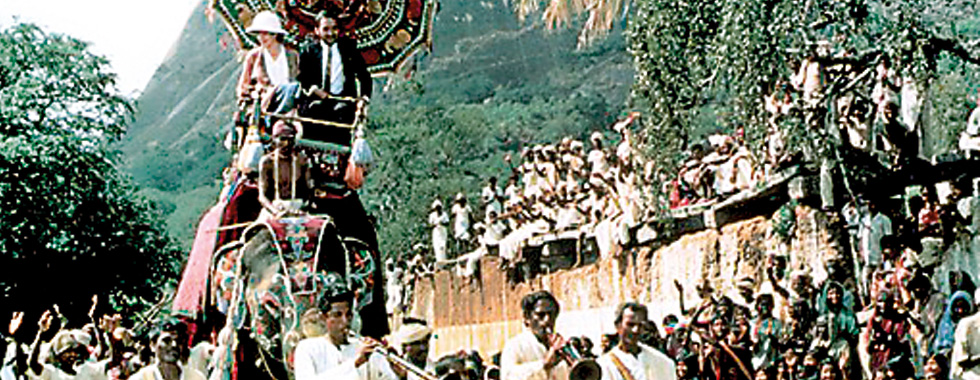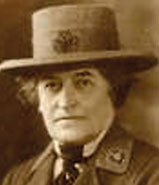Sunday Times 2
When British girls went on husband-hunting in the Raj
By Annabel VenningCleaving their way through the sapphire waters of the Indian Ocean, the ships bore their cargo into port. Whether at Colombo, on the island of Ceylon (now Sri Lanka) or one of the Indian ports such as Madras, Calcutta or Bombay, the cargo was the same: hordes of eager young women, sweltering in the corsets, stockings and flannel underwear they were required to wear beneath their dresses – some still suffering from sea sickness as they staggered down the gangway into the searing heat.

Heady romance: A colourful scene from David Lean's 1984 film A Passage To India
These were the girls of the ‘Fishing Fleet’, and they had come to India for the purpose of landing their catch – a husband. If they succeeded in their quest, they might soon find themselves ensconced in a spacious bungalow with a retinue of servants, as the wife of a senior official or officer. Alternatively, if their beau was posted ‘up country’, they could end up eking out a miserable existence in a remote jungle or mountain range, fighting off the ravages of termites, cholera and bubonic plague.
Such were the fates of the Fishing Fleet who came to India in their thousands, right from the first days of Britain’s trade with India in the 17th century, to the twilight of the Raj as India headed toward independence in 1947.
Now, a fascinating new book by historian and former Daily Mail writer Anne de Courcy chronicles the lives of these intrepid women.
For generations, young men had sailed out to India as soldiers, bureaucrats and businessmen. Once there, some took Indian wives and mistresses and sired children with them. Others sated their lust in the numerous brothels that sprang up to serve the British.
In regimental towns, the brothels were even licensed and the prostitutes inspected for sexually-transmitted diseases and compulsorily treated, as they were back home in Britain.
But the Contagious Diseases Act, which required the examination of any woman suspected of being a prostitute near a garrison, was repealed in India in 1888, after which rates of venereal disease soared, incapacitating almost half the British soldiery (only soldiers, not officers, were allowed to use brothels).
So in the eyes of the authorities, shipping out British girls to keep their menfolk happy during their long exile made perfect sense. The East India Company – which effectively ruled over much of India until 1857, when the country came under British government rule – even helped provide the men with brides by paying the passage of single girls to come to India.
In 1671, 20 girls went out to Bombay on the promise of an allowance of £300 a year (about £25,000 today) for life from the Company if they married there. If they misbehaved in any way, they would be put on a diet of bread and water and shipped straight home. Any who did behave themselves, but failed to find a husband after a year, would be sent back in disgrace as a ‘returned empty’.
As a result, girls felt under huge pressure to marry the first eligible man who asked them. Many courtships were conducted within days. The first few nights ashore, the girls with the smartest social credentials would be invited to dinner by the ship’s captain. All the eligible British men in the neighbourhood would be asked along – young and old – to look over the cargo.
The prettiest girls would be snapped up quickly, the plainer ones would have to try their luck in India’s more remote stations, in the hopes of finding a man sufficiently desperate for a wife to stave off loneliness and sexual frustration.By the 20th century, the advent of steamships and quicker voyages meant that men could more easily return home on leave to find a suitable bride. But with the desperate shortage of eligible men at home after World War I, shiploads of hopeful girls still continued to traverse the Indian Ocean in search of a husband.
Some were daughters returning to their parents in India after ten years at school in Britain. For others, it was a journey into the unknown, and many who came out on the steamships were innocent and unworldly.
Twenty-one-year-old Violet Hanson came to India in 1920 to escape the shame of a brief, disastrous marriage at home. She had married her brother’s tutor, but having never been taught the ‘facts of life,’ it was only months after the wedding that Violet saw a doctor and learned that she was still a virgin.
It transpired that her husband was homosexual. So the marriage was annulled, and Violet was packed off to India with an aunt. She soon became engaged to a handsome young officer, and the shame of her first marriage was expunged.
In the days of sail, the voyage could take months and was fraught with danger – primarily pirates and storms. In 1840, one ship coming into Bombay sank with the loss of 80 troops and all the women and children passengers, while the crowds on the shore watched helplessly.
Steamships, which took over from sail in the mid-19th century, were safer, faster and more comfortable, as well as romantic. Many a Fishing Fleet girl became engaged during moonlit strolls on deck with a handsome young man, although not all shipboard romances ended happily.
Enid Shillingford, who went to India in 1921 aged 24, fell in love during the journey with a handsome young officer, who duly proposed. They planned to wed when they reached Ceylon, but two days before their arrival Enid was informed that the man was already married.
Humiliated and heartbroken she took the next ship back to England. Five years later, she went back and this time was luckier. She fell in love with another gentleman on board, and was married on arrival.
Once in India, those who were either returning to their parents ‘up country’, or who had found a husband who lived far from the coastal ports, faced long, often arduous journeys by bullock cart, camel or elephant.
The advent of the railways made these journeys easier, but they could still take several days and the trains were stiflingly hot in summer. When Edwina Ashley, later Lady Mountbatten, travelled through India in temperatures of around 50C the train door handles were too hot to touch.
As well as getting to grips with the climate, there was the rigid social etiquette that governed Raj life.People were seated at dinners according to rank. Single girls had to be chaperoned at all times. And British women must on no account mix with Indians, other than servants.
The exceptions to this rule were the maharajahs, the hereditary rulers of India’s princely states who had surrendered power for fabulous wealth.Rosita Forbes met the Maharajah of Jodhpur in 1930, and described his fabulous palace with writing table sets encrusted with precious jewels and children’s balls set with rubies. He had a cap made of the finest solitaire diamonds.
While white girls might accept a maharajah’s hospitality, inter-racial marriage, even with a royal prince, remained unthinkable and forbidden by the Viceroy. ‘I was told who was within my marriage range and who wasn’t,’ remembered Iris James. ‘Anybody, however old and decrepit, bald or dull, was a possible husband, as long as he was white. Anybody with the slightest touch of colour wasn’t.’
One girl, Florry Bryan, defied this convention, falling in love with the wealthy Maharajah of Patiala. They began an affair in 1893 and, finding that she was pregnant, wed in secret, scandalising British and Indian society, both of which shunned Florry.
She gave birth to a son, who died in infancy. Florry passed away in 1896, and her husband soon followed her to her grave.
A more common scandal was adultery. Every summer, the wives and children of British officials would make their way up to the hill stations to escape the worst of the heat, while their husbands continued to toil away on the burning plains, joining them on leave when they could.
These hill stations, such as Simla, described as a place where ‘every Jack has somebody else’s Jill’, became hotbeds of extra-marital intrigue. ‘Perhaps it was the mountain air that caused so many women to cast away their inhibitions,’ pondered John Masters, a young Gurkha officer. ‘Perhaps the friendly unfamiliar wood fires burning on the hearths warmed their blood and made them think with fervour of romps on tiger skin divans.’
© Daily Mail, London
comments powered by Disqus















